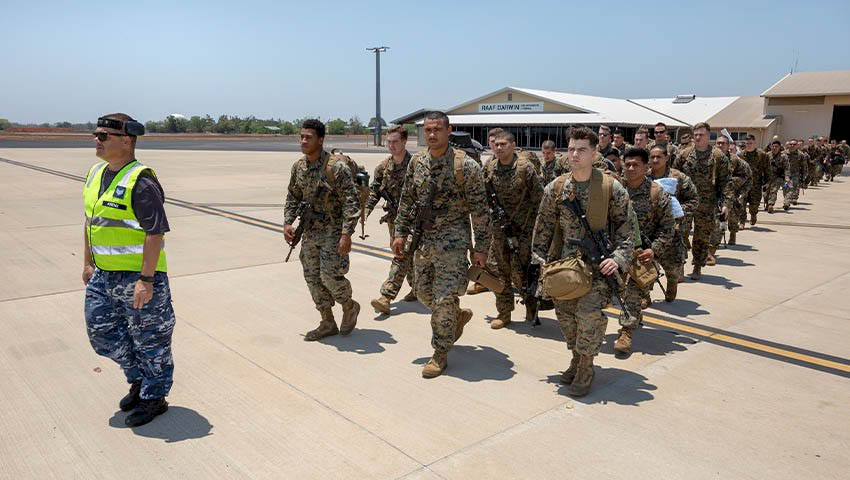Why Canberra must proactively lay the ground work for an expanded US presence in Australia.
In September, just days after the AUKUS partnership was announced, Minister for Defence Peter Dutton and Foreign Affairs Minister Marise Payne confirmed plans to bolster the United States’ military presence in Australia after meeting with Secretary of State Antony Blinken and Secretary of Defense Lloyd Austin as part of AUSMIN discussions.
As an extension to the bilateral Force Posture Working Group convened in May 2021, the counterparts endorsed areas of expanded co-operation across the air and maritime domains.
This includes:
- enhancing air co-operation through the rotational deployment of US aircraft of all types in Australia and appropriate aircraft training and exercises;
- bolstering maritime co-operation by increasing logistics and sustainment capabilities of US surface and subsurface vessels in Australia;
- ramping up land co-operation by conducting more complex and more integrated exercises and greater combined engagement with allies and partners in the region; and
- the establishment of a combined logistics, sustainment and maintenance enterprise to support high end warfighting and combined military operations in the region.
As part of the plan, US personnel and military assets would also be based in key strategic locations across the country.
In addition to hosting troops in the Top End, Australia would welcome US maritime and air platforms in the southern states.
This is expected to include submarines, bombers, and surveillance aircraft, the latter of which could be sustained at RAAF Base Richmond and RAAF Base Amberley.
This expansion was confirmed as a key strategic priority of the US just months later, with President Joe Biden approving recommendations from the latest Global Posture Review, which include:
- seeking greater regional access for military partnership activities;
- enhancing infrastructure in Guam and Australia;
- prioritising military construction across the Pacific islands; and
- new US rotational aircraft deployments and logistics cooperation in Australia.
The US Department of Defence justified these measures by pointing to the ramp up in aggression from China and North Korea.
“It is no surprise that the Indo-Pacific is the priority region for the review, given the secretary's focus on China as America's pacing challenge,” the Pentagon noted.
“The review directs additional co-operation with allies and partners to advance initiatives that contribute to regional stability and deter Chinese military aggression and threats from North Korea.”
According to Michael Shoebridge, ASPI’s director defence, strategy and national security program, it’s no surprise Australia has been selected to facilitate this bolder US strategy in the region.
“US decisions on where in the Indo-Pacific it will disperse its forces — army, navy, air force and marines — will be directly influenced by the political environment in particular places, the geographic advantages of locations, the industrial support available and the partnerships that an increased US force presence will enable,” he writes.
“On all these factors, Australia scores highly, with the north of the country providing access to south-east Asia and the west providing access to the Indian Ocean.”
Canberra’s capacity to spearhead investment in the development of expanded facilities to meet the US military’s requirements is also an attractive proposition for Washington.
“This combination of politics, geography, direct military partnership and Australian investment provides all the ingredients to make Australia a ‘deployment and sustainment hub’,” Shoebridge writes.
But in playing its part to support a bolder US presence in the region, he adds, Australia must invest billions to expand facilities at Stirling naval base in Western Australia and in Darwin Harbour, along with associated air facilities in the north and west of the country.
“In northern Australia, it probably also means starting something new with the US Army, whose Pacific element is larger than the whole Australian Army and which is seeing its future as dispersing from its long-term primary focuses on Hawaii, South Korea, Alaska and Japan,” Shoebridge observes.
“The US Army has been the forgotten service in force posture initiatives so far, but the AUSMIN communiqué tells us this is changing, referring to ‘enhanced land co-operation by conducting more complex and more integrated exercises and greater combined engagement with allies and partners in the region’.
“Working with the Australian Army and wider joint force on Australian training ranges and exercises areas will look uniquely roomy and valuable in comparison with the many limitations the US Army faces elsewhere.”
Shoebridge calls on the Commonwealth government to “get ahead of slow processes” and proactively communicate and execute proposals to support an expanded US presence.
“It’s time for some high-vis vests and ribbon-cutting ceremonies to be a part of our near future, with open borders that allow our political leaders to turn up in Darwin and Perth,” Shoebridge writes.
“Biden’s global posture review can only bring results for Australian, US and Indo-Pacific security if there are active partners willing to invest to accelerate the review’s outcomes. Let’s demonstrate we understand enough about our own security needs to do so.”
Get involved with the discussion and let us know your thoughts on Australia’s future role and position in the Indo-Pacific region and what you would like to see from Australia's political leaders in terms of partisan and bipartisan agenda setting in the comments section below, or get in touch with


